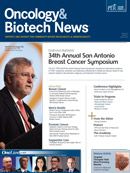Publication
Article
Oncology & Biotech News
Anastrozole Plus Fulvestrant Improved Survival in Metastatic Hormone Receptor-Positive Breast Cancer
Author(s):
The combination of anastrozole and fulvestrant improved survival when used as first-line therapy in postmenopausal women with metastatic HR-positive breast cancer compared with anastrozole alone.
Rita S. Mehta, MD
The combination of anastrozole and fulvestrant improved survival when used as first-line therapy in postmenopausal women with metastatic hormone receptor (HR)-positive breast cancer compared with anastrozole alone, according to results of a phase III study conducted by SWOG and presented at the 2011 CTRC-AACR San Antonio Breast Cancer Symposium in Texas.
Both anastrozole and fulvestrant are used in the treatment of breast cancer, but not in combination. Anastrozole reduces the production of estrogen, and fulvestrant interferes with estrogen receptor signaling, explained lead author Rita S. Mehta, MD, an associate professor of Medicine at the University of California Irvine Medical Center.
“We hypothesized that the two different mechanisms of actions that act on estrogen would be better combined than when using one drug at a time. The survival improvement was particularly exciting because these patients have not had a new treatment that gave them an overall survival benefit in more than a decade,” Mehta said.
The study was initiated in 2004 at 72 institutions; 707 postmenopausal women with metastatic HR-positive breast cancer were randomized to the combination of anastrozole plus fulvestrant or anastrozole alone, and treated until disease progression. Anastrozole was given orally at the standard dose of 1 mg/day in both arms. Patients randomized to the combination also received fulvestrant 250 mg injected every 28 days. No prior chemotherapy, hormonal therapy, or immunotherapy for metastatic disease was allowed. If patients had neoadjuvant or adjuvant therapy initially,
12 months had to elapse before they could enroll in this trial.
The 2 arms were well balanced for demographic and disease characteristics. Median age was about 65 years, about 40% received prior adjuvant tamoxifen therapy, about 33% received prior adjuvant chemotherapy, and about 9% were HER2-positive.
The study met both the primary endpoint of progression-free survival (PFS) and the secondary endpoint of overall survival (OS) for the combination of anastrozole plus fulvestrant. Median PFS was 13 months for anastrozole alone versus 15 months for the combination, representing a 20% improvement favoring the combination (P = .0070). An unplanned analysis by prior tamoxifen use was conducted. Among 280 patients treated with prior adjuvant tamoxifen, median PFS was 14.1 months versus 13.5 months, respectively, with no significant difference between treatment arms. For the 414 patients with no prior adjuvant tamoxifen, median PFS was 12.6 months versus 17 months, respectively (a 26% improvement for the combination, P = .0055).
Median OS was 41.3 months with anastrozole alone versus 47.7 months with the combination, for an absolute gain of about 6 months (P = .049). Median OS was not statistically different between the 2 treatment arms for those who had prior adjuvant tamoxifen; among patients who did not have prior tamoxifen, median OS was 39.7 months versus 47.7 months, respectively, favoring the combination (P = .0362).
Both treatments were similarly well tolerated, Mehta said. However, Grade 5 toxicity was reported only in the combination arm (3 patients: 2 pulmonary embolism, 1 cardiovascular ischemia). Grade 4 toxicity was reported in 2 additional patients in the combination arm (1 pulmonary embolism and 1 lymphopenia and neutropenia). Four patients on anastrozole alone had Grade 4 toxicities (thrombolysis/ embolism, arthralgia, thrombocytopenia, and dyspnea). Grade 3 toxicities were reported in 13% in the combination arm and 11% on anastrozole. These included musculoskeletal pain, fatigue, hot flashes, mood alterations, and gastrointestinal symptoms.
Adverse events were not significantly different between treatment groups, and there were few treatment-related discontinuations (4 in the anastrozole- alone arm and 1 in the combination arm).
Prior tamoxifen may be an important factor, as was shown in the unplanned analysis, Mehta said. The benefit of the combination of anastrozole and fulvestrant appeared to be mainly in tamoxifennaïve patients in this trial.
“We need to better understand other possible predictive factors, since the prior tamoxifen factor could be a false lead from an unplanned analysis,” Mehta concluded.










